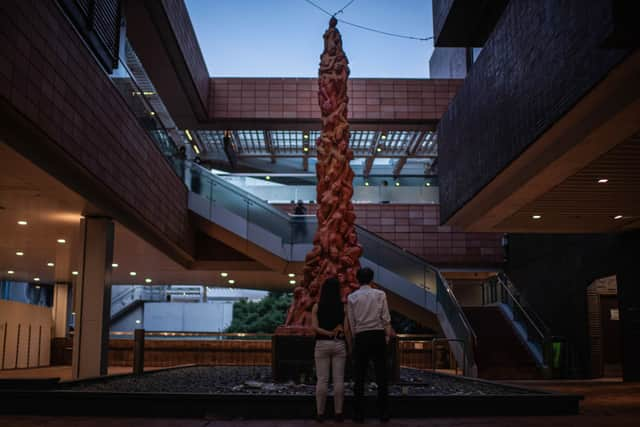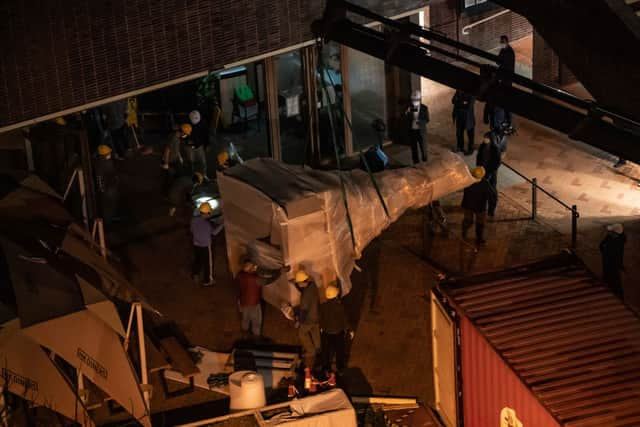What happened at Tiananmen Square? 1989 massacre and ‘Tank Man’ images - how many died as China removes statue
This article contains affiliate links. We may earn a small commission on items purchased through this article, but that does not affect our editorial judgement.


A monument at a Hong Kong university that commemorates the 1989 Tiananmen Square massacre has been removed despite the objections of its Danish creator.
Jens Galschiøt’s ‘Pillar of Shame’ was removed from the University of Hong Kong late on Wednesday (22 December), as Beijing continues to crack down on political dissent in Hong Kong.
Advertisement
Hide AdAdvertisement
Hide AdThe sculpture is one of the last remaining public memorials to the Tiananmen Square massacre, and depicts torn and twisted bodies to symbolise those who died.
The statue was first erected in 1997 to mark the eighth anniversary of the protests, and is one of a series of similar sculptures by Galschiøt located around the world and depicting “shameful events which must never recur.”
But what happened at Tiananmen Square, and why was the statue removed?
Here is everything you need to know about it.
Why was the statue removed?
In October 2021 the University of Hong Kong requested that the statue be removed, though it did not cite a specific reason for the request.
Advertisement
Hide AdAdvertisement
Hide AdThe university later released a statement claiming the statue belonged to "an external organisation", which had publicly announced its disbandment and was requesting its removal on the "latest risk assessment and legal advice".
Sculptor Galschiøt said that he was "shocked" when hearing about the potential removal and that he, who considered himself the sole owner of the statue, had never been contacted by the university.
He urged the university to allow the statue to remain standing, saying that it would help the world to remember the peaceful demonstrators who "were killed for expressing their wishes for political participation".
He said that he hoped to "be able to transport the sculpture out of Hong Kong under orderly conditions", and that any damage to the statue would be the university's responsibility.
Advertisement
Hide AdAdvertisement
Hide AdThe university’s legal representation then announced it would no longer be representing the university in the matter of the statue, bowing to pressure from civil society groups.


According to local media, the University of Hong Kong blockaded the Haking Wong Podium - where the Pillar of Shame stood - on the evening of 22 December.
The university sent in workers prepared with trucks with cranes for the statue’s demolition, and security guards who obstructed journalists and students from taking photos.
By daylight, the statue had disappeared.
Galschiøt expressed his shock in a public message, referring to Hong Kong as a lawless place and announcing that he would claim compensation.
Advertisement
Hide AdAdvertisement
Hide AdThe university has said it will put the statue, which has been on display at the campus for 24 years, into storage.
What happened at Tiananmen Square?
The Tiananmen Square protests of 1989 were student-led demonstrations calling for free speech and a free press in China.
Most protesters did not like the way the Communist party of China ran the economy, and many also wanted a change towards more democracy.
On 4 June 1989, the government used force to end the protests, using troops to fire on protesters, which left many people injured or dead.
Advertisement
Hide AdAdvertisement
Hide AdThe exact number of victims is not known today; the Chinese government’s modest estimate puts the figure between 200 and 30 three hundred people, while some estimates say the number of casualties could be as high as 10,000.
The official Chinese position on the events was that the protests needed to be dispersed in order not to harm the stability of the country, but images of the incident were broadcast around the world.
What happened to ‘Tank Man’?
One of the most enduring images is that of the famous ‘Tank Man’, a lone, unarmed protester facing down a convoy of tanks as they attempted to leave Tiananmen Square.
Now one of the most iconic photographs of the 20th century, footage shows the tank driver trying to go around him as ‘Tank Man’ continually moves into the tank's path.
Advertisement
Hide AdAdvertisement
Hide AdHe continues to stand defiantly in front of the tanks, before climbing up onto the turret of the lead tank to speak to the soldiers inside.
After returning to his position in front of the tanks, the man is eventually pulled aside by a group of people.
What happened to ‘Tank Man’ is not known, though Chinese leader Jiang Zemin stated in 1990 that he did not think the man was killed; Time magazine later named him one of the 100 most influential people of the 20th century.
A message from the editor:
Thank you for reading. NationalWorld is a new national news brand, produced by a team of journalists, editors, video producers and designers who live and work across the UK. Find out more about who’s who in the team, and our editorial values. We want to start a community among our readers, so please follow us on Facebook, Twitter and Instagram, and keep the conversation going. You can also sign up to our newsletters and get a curated selection of our best reads to your inbox every day.
Comment Guidelines
National World encourages reader discussion on our stories. User feedback, insights and back-and-forth exchanges add a rich layer of context to reporting. Please review our Community Guidelines before commenting.
